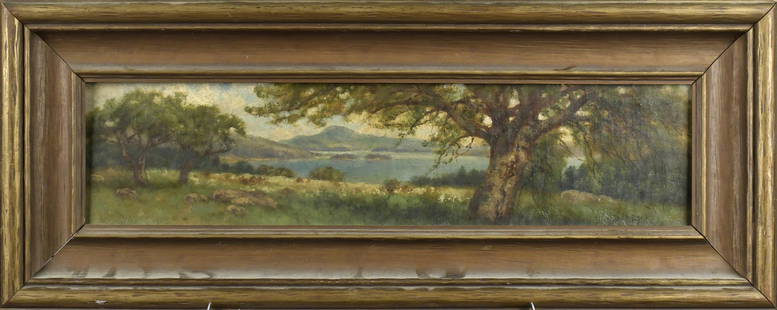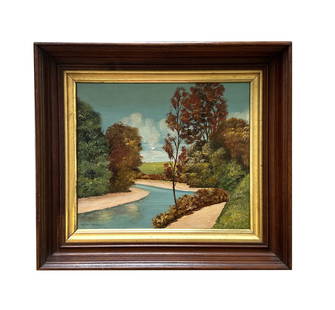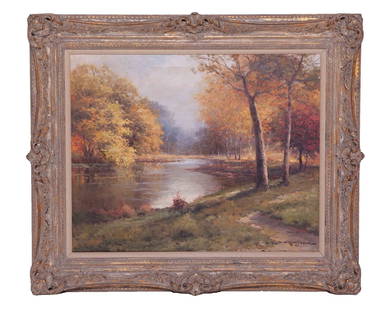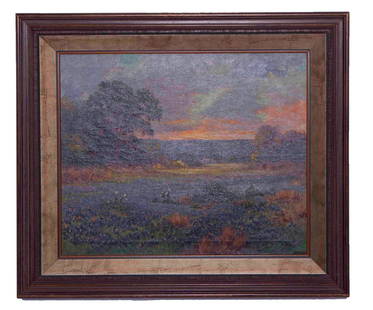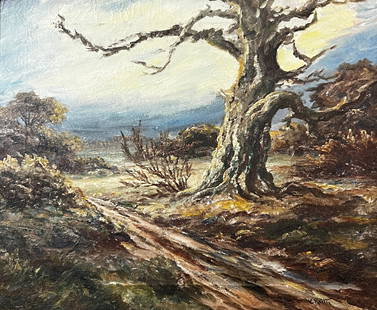
O/C 'Children In The Woods' by William Keith
William Keith Sale History
View Price Results for William KeithRelated Paintings
More Items from William Keith
View MoreRecommended Art
View More






Item Details
Description
Medium: Oil
Support: Canvas
Artist: William Keith
Artist Dates: 1838 - 1911
Country of Origin: America
Title & Description: Painting depicts two children dwarfed by imposing trees along a path.
Signature: "W. Keith" lower left
Date of Work: C. 1900
Frame: Original
Work Size: 20" H x 16" W
Frame Size: 25.5" H x 21" W x 2" D
Weight: 4.6 pounds
Condition: Unlined, some minor in painting in trees and ground. Small patch on verso covering a pinhole puncture.
Meta: painting, art
Artist Biography: A native of Scotland, William Keith became in the late 19th and early 20th centuries a leading Northern-California landscape artist. In fact, he was so well known that he is referred to as the "Dean of California painters." His romanticized views of nature found much favor among the culturally aspiring citizens of San Francisco and hung in many foyers and dining rooms in their elegant homes. He completed thousands of paintings and drawings, and many of them were lost in his studio in the fire of 1906.His early works are dramatic mountainscapes in a realistic style adopted from the Dusseldorf School of Germany. The paintings of the last two decades of his life are looser and obviously influenced by his exposure in France to the Barbizon School of landscape painters, who were the first colony of painters to complete paintings "en plein air," or directly from nature rather than in studios. A forerunner of Impressionism, this style also included Tonalism espoused by Barbizon painter Camille Corot (1796-1875) and also apparent in Keith's later works, which are darker, smaller, and much more intimate with emphasis on mood.Born in Aberdeenshire, Scotland, Keith came to New York with his family and, apprenticed to a wood engraver. In 1859, he moved to San Francisco where he worked for an engraver and later set up his own engraving business. Studying with Samuel Marsden Brookes in 1863, he determined to become a painter.He married artist Elizabeth Emerson and did watercolor painting with her guidance. In 1868, he became a full-time painter, and that same year was commissioned to paint scenes along the Columbia River including Mount Hood. By August 1869 he had sold enough paintings to finance an extended journey to the East Coast and Europe including Dusseldorf, Germany throughout most of 1870, studying with Albert Flamm. After a visit to Paris, he expressed great admiration for "the modern school of French landscape painting including the Barbizon School. During the winter of 1871-1872, the Keiths lived in Boston where they shared a studio with William Hahn. Keith's work received critical acclaim there and in New York at the National Academy of Design.In 1872, he returned to San Francisco. A friendship with naturalist John Muir exposed Keith to many remote places and in-depth knowledge of nature. During the 1870s, he painted several "epic" eight by ten-foot High Sierra views. He also visited Alaska, and his paintings of Alaska were exhibited upon his return to San Francisco in a show at the Bohemian Club, titled 'Dreams of Alaska'. Keith's Alaska works are significant because they are not close transcriptions of actual scenery, but rather are fantasies inspired by Alaska. They are important as they represent a major break from the documentary tradition in landscape painting of Alaska, as they show an interest in capturing its spirit versus just the topography.The first wife of William Keith died in 1882, and in 1883, he married Mary McHenry, the first woman graduate of Hastings Law School. They soon went to Europe, and Keith studied portrait painting in Munich with consultations from J. Frank Currier and Carl Marr for two years. Keith then settled for the remainder of his life in Berkeley, California, at 2207 Atherton Street. His studio was in San Francisco where he commuted daily, painted prolifically, and taught many classes, mostly for aspiring female artists .In 1891, he shared his studio for several weeks with East Coast Tonalist George Inness, Sr. (1825-1894). Both men painted in a similar style and were followers of the mystical teachings of Swedenborg. Among the locations where Inness and Keith painted together were Monterey and Yosemite, and it was reported they discussed art from every possible angle. Under Inness' influence, Keith painted more than ever in a Barbizon-influenced vein with many sunset and twilight scenes.By the early 1900s, Keith was likely one of the wealthiest artists in the United States and certainly earned the most money of any California-based artist. People from all over the world sought out his studio where it was said that he would specially select a painting for a client from behind a black velvet curtain, order everyone to be quiet, part the curtains, and set the work on a easel, flooded in light. It was unthinkable not to buy a painting on these occasions. Many of his paintings were shown in New York at the Macbeth Gallery, and in 1898, he had a special exhibition in New York. Keith died April 13, 1911, and his work is in most of the institutions representing major California artists. Saint Mary's College in Moraga, California has a collection of Keith paintings established by his biographer, Brother Cornelius.
Buyer's Premium
- 24.5%
O/C 'Children In The Woods' by William Keith
Estimate $300 - $500
9 bidders are watching this item.
Shipping & Pickup Options
Item located in Garrison, NY, usSee Policy for Shipping
Payment

TOP




















![Frances Raiff Wood O/C Mother & Child: Oil on canvas of mother and child sewing hat, Modernist. Frances Raiff Wood indistinct signature lower left. [24 x 20 inches]. Canvas torn on edges.](https://p1.liveauctioneers.com/1221/124522/63704106_1_x.jpg?height=310&quality=70&version=1532121215)













